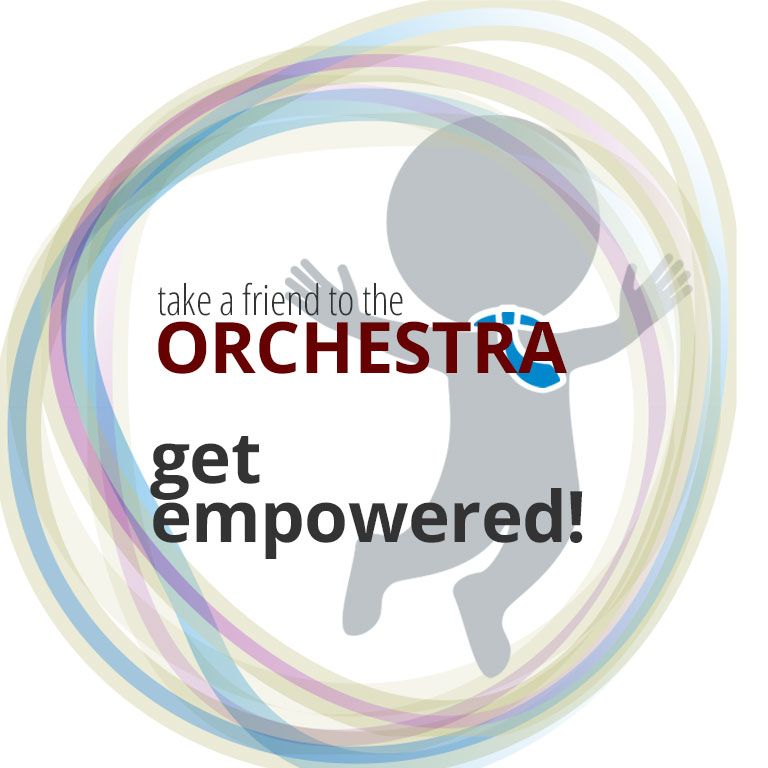Imagine there was a website that had everything you could possibly want to know about the double bass presented in a fun format, like if Steve Jobs could re-invent the Groves Dictionary of Music (iGroves – don’t laugh, it’s probably in development already). Fortunately, you don’t have to imagine; instead, visit Jason Heath’s doublebassblog.com, the virtual repository for all things double bass.
The second in “The Three Bassists” series of TAFTO 2007 contributions, Jason uses his experience as an “orchestral infantryman” to come up with ideas for what musicians can do to make the concert experience better…
Take A Friend To Orchestra
By: Jason Heath
The experience of actually seeing an orchestra live is magical. Bows moving in tandem, melodies flitting from section to section, the anticipation of the crowd, the conductor waving his arms–it is a thrill unique to the orchestral concert experience. Audio and video recordings can’t even come close to the feeling of actually being there, hearing music being created in that moment, filling the hall with sound and then dissipating just as quickly.
As a veteran orchestral infantryman, I have been playing these kinds of events my whole life. The satisfaction I get from a well-executed concert is very personal, subtle, and (I suspect) quite different than the experiences of most audience members. The night where the bass section plays that pizzicato at the exact perfect time, the way the flute line dissolves into the string line just right, the fussy tempi chosen for a specific section that elicits the perfect effect–this sort of minutiae is what gives me pleasure, and these are the sorts of fussy details that the public is not likely to notice.
Because of my intimate familiarity with the form, I am often at a loss when talking about orchestral music with non-musicians. I often wonder exactly what the appeal is for most audience members. What does a live orchestral event offer to a person that is special from other activities? Why not just put a CD of the Berlin Philharmonic into the home stereo and kick back with a glass of wine? There isn’t the hassle of traveling to the concert, finding parking, coat check, finding seats, dealing with noisy patrons…..
We musicians may forget that, to most people, a concert really is a special event outside of the humdrum of their daily routine. For me, putting on my tails and heading over to the hall is going to work–just another “day at the office.” For audience members, however, it is a special event, a night at the theater, a highlight of the week. Since they don’t spend every day immersed in the orchestral world, audiences are usually unconcerned with the inconsequential details we orchestral musicians notice so clearly. They don’t know that Bill the clarinet player is probably going to play out of tune, or that Sally the violist thinks that the conductor is an idiot. They are there for the program, the soloist, the conductor, and the overall experience. These small details are, if noticed at all, simply background noise.
When picking what sort of orchestral concert to use as an introduction into this wonderful art form, there are definitely certain types of concerts that I would gravitate toward and types that I would steer clear from. I’d try to find a concert that is fun but not musically cheap. A concert of Webern and Schoenberg would be a bad idea, but so would song suites from Rogers and Hammerstein shows. Take a friend to a Pops concert, and that’s what they’ll think of orchestral music. Friends don’t let friends go to Pops concerts. Pick a concert that won’t bore them or baffle them, but don’t pick a concert of symphonic renditions of disco hits either.
In order to develop and keep an audience that sincerely derives pleasure from this art form (and not just a theater half-filled with businessman dragged there and dozing in the front row out of social obligation) we musicians need to understand what makes an orchestral concert special to the public, and to make sure that concerts fulfill what audiences want without peddling musical garbage to them.
I recently played a concert that was a perfect example of how to introduce newcomers to the classical music concert experience. The IRIS Chamber Orchestra (of which I am a member) performed a concert with the bluegrass trio Time for Three. The three young charismatic Curtis graduates making up this group mix traditional bluegrass tunes together with classical orchestral arrangements for an absolutely irresistible concoction. I saw nothing but smiles and toe-tapping as I looked out into the audience. For more information on this group, you can read my blog Time for Three. Check them out–they happen to be some of the best ambassadors of new directions in classical music out there right now.
This group demonstrates one of the most important things about how to promote our wonderful art form to non-converts, which is to meet them halfway. Take something that is more accessible to a non-classical music lover but still has integrity, vibrancy, and excitement.
The IRIS Chamber Orchestra program featuring Time for Three was bookended by the quirky Symphonic Variations by Antonin Dvorak and Schumann’s Symphony No. 4 in D minor. Both of these works are great, although certainly not as accessible as the bluegrass/classical set of Time for Three, but Music Director Michael Stern wove these warhorses into a thematic program along with the bluegrass music in a very convincing way. He spoke directly to the audience in an illuminating but lighthearted way, explaining why he chose these pieces and how they all relate to each other.
As a performer, I usually dread conductors talking. In our minds, we musicians are there to play, not sit, and we easily get impatient with conductors prattling on while we wait to play. Musicians onstage often exchange knowing glances when the conductor gets going in deep verbiage. Just watch the entire orchestra slouch in defeat the next time you are in an audience and a conductor starts talking. We are all counting the minutes that this talk adds to the concert length. For instance, I know that when Maestro _______ is on the podium I’ll be getting home a half-hour late due to the podium talk.
Numerous conversations with a variety of concertgoers have made me realize that the experience of a conductor offering verbal commentary and elaboration during the concert is actually a great thing for most people in the audience. This interaction, for many audience members, is one of the main reasons to go to an orchestra concert.
I really believe that it is the act of tying different pieces together into a cohesive event that makes an orchestral concert really special to patrons. This kind of cohesive program wins over new patrons and keeps old ones returning. It is an experience unique to symphonic music, and when it is done right the whole becomes greater than the sum of its parts, thrilling and satisfying audiences, keeping them coming back like bears to honey.



The following true story by Virginia Symphony bassist Tom Reel was printed in a local publication in Norfolk. It is offered here by the author as an example not of TAFTO but rather TCMTUS (Take Classical Music to Unsuspecting Strangers). This initial exposure to Classical Music for some country music lovers took place two decades ago. Today the VSO regularly offers Community Engagement performances (solos and chamber music) as well as “Art Attacks” which are slightly more ad hoc but not as random as the story here! The original story teller, Mike Daniels, today sits Principal Cello in the VSO.
COUNTRY CADENZA
Do you like flirting with danger? How about just taking a risk? Sometimes
venturing into the unknown yields rewards – other times just second guessing.
The summer of 1987 found Mike Daniels on such a venture. It is the tale of a
strange concoction – a mix of European classical music and American folk music.
And if you don’t think that entails any danger, you probably haven’t been to
McDibbs Bluegrass Bar in Black Mountain, North Carolina dressed in your
tuxedo and playing opus 20 by Ludwig van Beethoven on open mic night.
Mike was employed at the Swannanoa Chamber Festival for five weeks that
summer. Among the repertoire prepared was Beethoven’s Septet for Strings
and Winds in E-flat, a piece composed before his First Symphony. The youthful
Beethoven scored the work with a very prominent violin part. The other six
instrumentalists (playing viola, cello, bass, clarinet, bassoon and horn) face
challenges as well, but nothing like the violinist who even has a solo cadenza in
the final movement.
The French Horn player, Bill Hoyt, had been lobbying all summer for a foray to
McDibbs on open mic night for a performance of the Septet. With some
trepidation, the rest of the group finally agreed. It might be hilarious. It might be
just foolish. They upped the ante by going after a festival recital in their tuxes.
Everyone was a little nervous about the reception they might get except Bill.
Maybe a horn can be tossed into its case for an emergency retreat more quickly
than a clarinet, bassoon or strings.
What the intrepid musicians knew about their audience was that they liked guitar,
mandolin and banjo pickin’ and country fiddlin’. They liked trucks. They liked
beer. They had not come from the chamber music recital in Swannanoa that
evening! What the musicians did not know was what objects weren’t tied down
or how good the aim of their listeners was after a few beers. And they did not
want to find out.
Assembled on stage, they began at the top. They got to the end of the first
movement and were greeted with silence. This wasn’t the restraint of an
audience experienced in classical music politely holding their applause until the
Finale. This was something different. As Mike noted, “The looks ranged from
total boredom to anger.” Looks of rapture were notably absent. Even Bill Hoyt
must have been asking himself, “What was I thinking?” Mere embarrassment
was the least of their worries now. The stony silence felt heavy and ominous.
The situation called for a new idea and violinist Glenn Basham had one. He
directed the group to proceed directly to the last movement. Another
movement? Was this really the best strategy? At least they would skip the slow
music. They began the last movement without incident until Glenn started his
cadenza. Then it happened.
Glenn transitioned smoothly from Beethoven’s cadenza into Orange Blossom
Special, complete with train whistle double stops and his bow flying across the
strings. Mike remembers looking out at the momentarily stunned audience in
their jeans and boots with “everyone’s eyeballs getting real big.” Then in a flash
the hollerin’ and foot stompin’ began as Glenn played a killer version of the folk
standard he had learned during his country fiddle days as a youngster. By the
time he seamlessly returned to the last notes of the original cadenza everyone
was on their feet screaming.
The response was so enthusiastic that the group went on to play the other
movements of the Septet. The audience was attentive and can be forgiven for
applauding between movements the rest of the way.